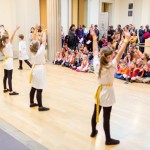Did you take your pupils to the British Museum Supplementary Schools Weekend?
‘Our supplementary schools programme began in 2012 and since then we have organised six activity weekends which support community schools and their wider communities to access the Museum’s collection, but this was the first time that the entire programme of activities has been created by young people. The journey began in May when we invited supplementary schools to enter a competition to create an artistic project based on their favourite objects in the Museum. Three supplementary schools were chosen to take part, each partnered with an artist who worked with them over a series of three workshops to create a performance or installation to be showcased at the Museum during the activity weekend.
 Students from EC Lighthouse, a Lithuanian supplementary school in Tower Hamlets, took part in a dance project supported b Katie Green. Responding to objects in theWolfson Gallery: Roman Empire (Room 70), they created a performance piece examining the interconnected stories of Julius Caesar, Cleopatra and Mark Antony. With an emphasis on bringing museum objects to life through movement, the dancers began by exploring how people represented themselves in the Roman era, reawakening the statues and busts in the gallery. They then went on to work with a broad range of themes including loyalty, power, competition and conflict to create their final piece which was performed at the Museum.
Students from EC Lighthouse, a Lithuanian supplementary school in Tower Hamlets, took part in a dance project supported b Katie Green. Responding to objects in theWolfson Gallery: Roman Empire (Room 70), they created a performance piece examining the interconnected stories of Julius Caesar, Cleopatra and Mark Antony. With an emphasis on bringing museum objects to life through movement, the dancers began by exploring how people represented themselves in the Roman era, reawakening the statues and busts in the gallery. They then went on to work with a broad range of themes including loyalty, power, competition and conflict to create their final piece which was performed at the Museum.
 Students from IYDA, a youth group for children and young people in the Farsi speaking communities (predominantly Iranian and Afghan), took part in a creative arts project inspired by the stone reliefs from the palace of Persepolis, displayed in the Rahim Irvani Gallery: Ancient Iran (Room 52). Based on their visit to the gallery, the young people were asked to imagine that they were a ruler, like King Darius I, who had commissioned a new palace. They were asked to think about what murals and scenes they would include, showing the type of ruler they would be. Supported by artist Stephanie Hartman, they experimented with different art techniques and created palace tiles and a garden mural for an installation that was displayed in the Great Court.
Students from IYDA, a youth group for children and young people in the Farsi speaking communities (predominantly Iranian and Afghan), took part in a creative arts project inspired by the stone reliefs from the palace of Persepolis, displayed in the Rahim Irvani Gallery: Ancient Iran (Room 52). Based on their visit to the gallery, the young people were asked to imagine that they were a ruler, like King Darius I, who had commissioned a new palace. They were asked to think about what murals and scenes they would include, showing the type of ruler they would be. Supported by artist Stephanie Hartman, they experimented with different art techniques and created palace tiles and a garden mural for an installation that was displayed in the Great Court.
Finally 12 children aged 4-6 from the Czech School without Borders, London took part in a storytelling project with author and playwright Sam Gayton, based on themechanical nef, an automated clock in the form of a ship, displayed in the Clocks and Watches gallery. When the children visited the nef, they were mesmerised by how it was used to signal the beginning of a banquet by playing music, gliding along the table and firing its cannons, although some weren’t so sure they would like it on their table at home!
Photos by Benedict JohnsonRead the latest blog page here.
Exploring objects and sharing cultures: supplementary schools and the British Museum
blog.britishmuseum.org
Emma Taylor, Supplementary Schools Programme Coordinator, British Museum

Leave a Reply
You must be logged in to post a comment.